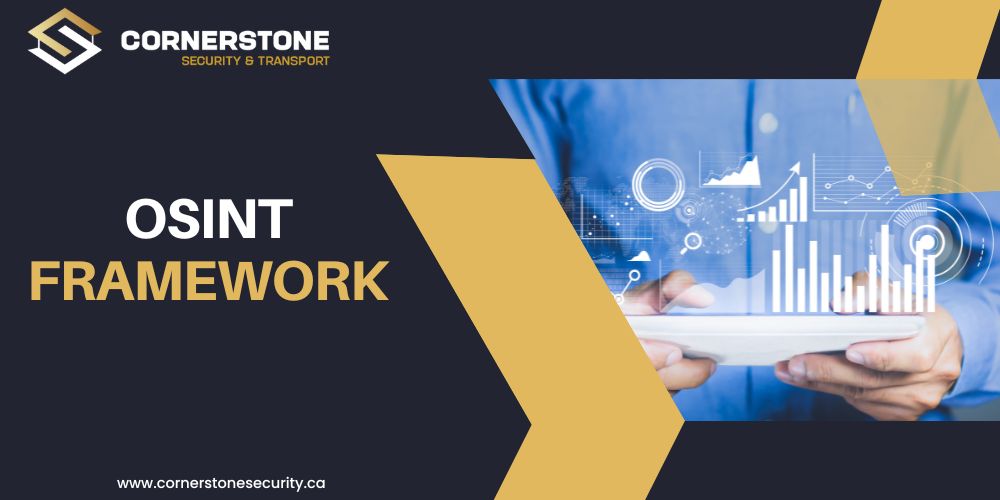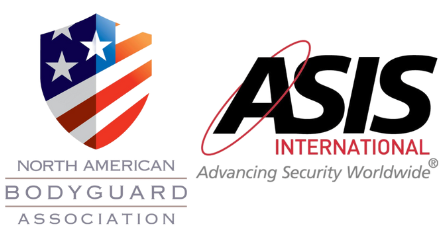The OSINT framework is a structured, strategic methodology used to gather and analyze publicly available data to identify risks, threats, and vulnerabilities. For executives, public figures, and high-net-worth individuals, this framework can be the first—and often most critical—line of defense in a world where information exposure creates real-world risk.
At Cornerstone Security & Transport, we integrate the OSINT framework into our custom security strategies to give our clients unmatched insight and protection. If you haven’t read our introductory article on what OSINT is and how it helps protect your business, we recommend starting there.
What Is the OSINT Framework?
The OSINT Framework isn’t a single tool or platform; it’s a categorized system of tools, sources, and methodologies that guide how intelligence is collected from public sources. It’s designed to help security professionals:
- Identify which types of data are relevant to a specific investigation (e.g., social media, IPs, email addresses).
- Use the right tools efficiently.
- Maintain ethical and legal boundaries while maximizing actionable insight.
This structured approach is what makes OSINT a powerful investigative ally, especially in executive protection scenarios.
How the OSINT Framework Works: The 5-Step Process
To protect people effectively, intelligence gathering needs to be deliberate, not reactive. The OSINT framework follows five essential steps:
- Planning and Objective Setting
The process begins with defining a goal. Are we monitoring a potential stalker? Scanning for exposure of sensitive executive information? Identifying pre-event threats?
Example: Before a CEO speaks at a public conference, we identify online discussions about the event, monitor extremist forums, and assess location-specific risks.
- Data Collection
Once the scope is defined, we collect relevant public data using categorized OSINT tools; search engines, forums, social media, breach databases, and even dark web marketplaces.
Example: For a public figure, we might search for mentions of their name across Reddit, X, Telegram groups, or data breach archives.
- Processing and Organization
Data is often messy. This step involves filtering out noise, validating authenticity, and organizing it into categories. Tools like SpiderFoot, theHarvester, or custom internal dashboards are used to sort and tag data.
Example: If we discover a breached company email linked to your executive, we categorize it based on source, severity, and threat potential.
- Analysis and Correlation
Here, we connect the dots: Are there patterns? Is someone surveilling your business? Are employees leaking sensitive info?
Example: A threat actor’s anonymous post about your event matches the language used in previous targeting posts. That’s a red flag and a call to act.
- Reporting and Action
Finally, findings are compiled into a brief or detailed threat assessment, complete with mitigation strategies. These reports are often shared with stakeholders like your CISO, legal team, or Cornerstone’s executive protection operators.
Example: Our report may recommend changes to event security posture, restrict certain digital communications, or coordinate with law enforcement.
Tools Commonly Used Within the OSINT Framework
While every case is unique, here are the tools we often draw from when building out intelligence:
| Tool | Use Case |
| Maltego | Mapping relationships across social, financial, and digital connections |
| Shodan | Discovering exposed tech infrastructure |
| HaveIBeenPwned | Checking for breached credentials |
| theHarvester | Gathering email, domain, and subdomain data |
| SpiderFoot | Automated reconnaissance across dozens of public sources |
| Google Dorking | Advanced search operators to uncover sensitive indexed info |
These tools form the “intelligence toolbox” we use inside the OSINT framework.
Active vs. Passive OSINT: What’s the Difference?
- Passive OSINT: Data collection without interaction (e.g., scanning breach records, viewing public LinkedIn profiles)
- Active OSINT: Involves some level of engagement or digital “touch” (e.g., sending friend requests, interacting with a suspicious actor)
At Cornerstone, we balance these approaches based on your risk tolerance, privacy concerns, and visibility. When discretion is paramount, passive techniques dominate. When more aggressive intel is needed, we shift strategies.
How OSINT Supports Executive Protection
Executives are high-value targets, both digitally and physically. OSINT helps by:
- Identifying threat actors or stalkers early
- Monitoring geotagged posts that could reveal travel plans
- Detecting event-specific chatter or protest organization
- Spotting impersonation or social engineering setups
By implementing the OSINT framework proactively, we help clients stay safe before a risk becomes an incident.
Frameworks Create Clarity, And Clarity Creates Safety
In a digital world flooded with data, the OSINT framework brings order, structure, and decisive insight. For Cornerstone clients, this means better situational awareness, faster threat response, and a comprehensive protection strategy built on facts, not assumptions.
Want to see how OSINT can be embedded into your executive protection plan? If you’re ready to apply structured OSINT intelligence to your protection plan, our team is here to help. Contact us to schedule a private consultation.
Request A Quote
Home page form for prospective customers.

